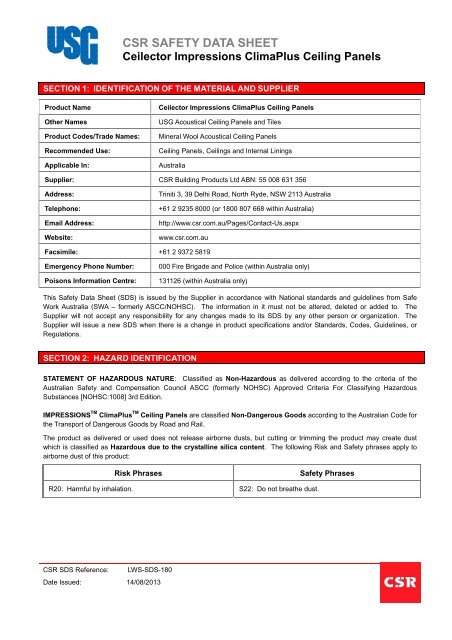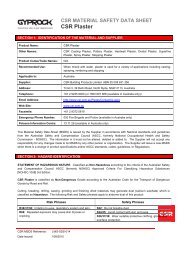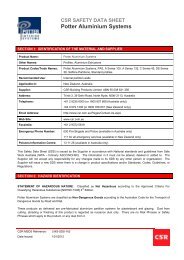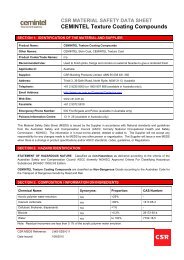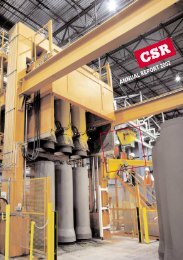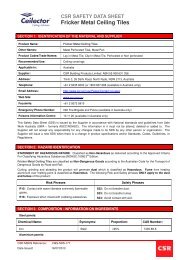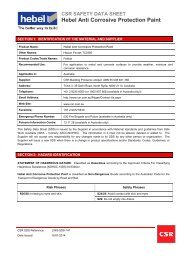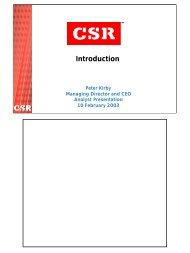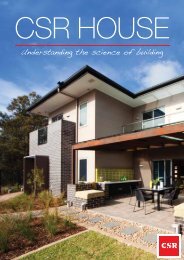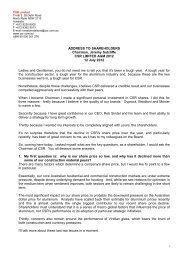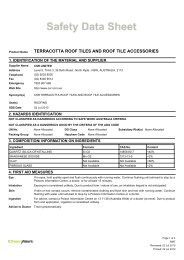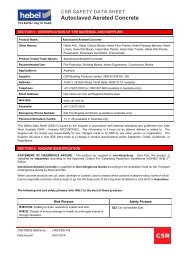USG Acoustical Ceiling Panels and Tiles (Impressions ) - CSR
USG Acoustical Ceiling Panels and Tiles (Impressions ) - CSR
USG Acoustical Ceiling Panels and Tiles (Impressions ) - CSR
You also want an ePaper? Increase the reach of your titles
YUMPU automatically turns print PDFs into web optimized ePapers that Google loves.
<strong>CSR</strong> SAFETY DATA SHEET<br />
Ceilector <strong>Impressions</strong> ClimaPlus <strong>Ceiling</strong> <strong>Panels</strong><br />
SECTION 1: IDENTIFICATION OF THE MATERIAL AND SUPPLIER<br />
Product Name<br />
Other Names<br />
Product Codes/Trade Names:<br />
Recommended Use:<br />
Applicable In:<br />
Ceilector <strong>Impressions</strong> ClimaPlus <strong>Ceiling</strong> <strong>Panels</strong><br />
<strong>USG</strong> <strong>Acoustical</strong> <strong>Ceiling</strong> <strong>Panels</strong> <strong>and</strong> <strong>Tiles</strong><br />
Mineral Wool <strong>Acoustical</strong> <strong>Ceiling</strong> <strong>Panels</strong><br />
<strong>Ceiling</strong> <strong>Panels</strong>, <strong>Ceiling</strong>s <strong>and</strong> Internal Linings<br />
Australia<br />
Supplier: <strong>CSR</strong> Building Products Ltd ABN: 55 008 631 356<br />
Address:<br />
Telephone:<br />
Email Address:<br />
Website:<br />
Triniti 3, 39 Delhi Road, North Ryde, NSW 2113 Australia<br />
+61 2 9235 8000 (or 1800 807 668 within Australia)<br />
http://www.csr.com.au/Pages/Contact-Us.aspx<br />
www.csr.com.au<br />
Facsimile: +61 2 9372 5819<br />
Emergency Phone Number:<br />
Poisons Information Centre:<br />
000 Fire Brigade <strong>and</strong> Police (within Australia only)<br />
131126 (within Australia only)<br />
This Safety Data Sheet (SDS) is issued by the Supplier in accordance with National st<strong>and</strong>ards <strong>and</strong> guidelines from Safe<br />
Work Australia (SWA – formerly ASCC/NOHSC). The information in it must not be altered, deleted or added to. The<br />
Supplier will not accept any responsibility for any changes made to its SDS by any other person or organization. The<br />
Supplier will issue a new SDS when there is a change in product specifications <strong>and</strong>/or St<strong>and</strong>ards, Codes, Guidelines, or<br />
Regulations.<br />
SECTION 2: HAZARD IDENTIFICATION<br />
STATEMENT OF HAZARDOUS NATURE: Classified as Non-Hazardous as delivered according to the criteria of the<br />
Australian Safety <strong>and</strong> Compensation Council ASCC (formerly NOHSC) Approved Criteria For Classifying Hazardous<br />
Substances [NOHSC:1008] 3rd Edition.<br />
IMPRESSIONS TM ClimaPlus TM <strong>Ceiling</strong> <strong>Panels</strong> are classified Non-Dangerous Goods according to the Australian Code for<br />
the Transport of Dangerous Goods by Road <strong>and</strong> Rail.<br />
The product as delivered or used does not release airborne dusts, but cutting or trimming the product may create dust<br />
which is classified as Hazardous due to the crystalline silica content. The following Risk <strong>and</strong> Safety phrases apply to<br />
airborne dust of this product:<br />
Risk Phrases<br />
Safety Phrases<br />
R20: Harmful by inhalation. S22: Do not breathe dust.<br />
<strong>CSR</strong> SDS Reference:<br />
LWS-SDS-180<br />
Date Issued: 14/08/2013
SDS for Ceilector <strong>Impressions</strong> ClimaPlus <strong>Ceiling</strong> <strong>Panels</strong> Page 2 of 7<br />
SECTION 3: COMPOSITION / INFORMATION ON INGREDIENTS<br />
Chemical Name: Synonyms: Proportion: CAS Number:<br />
Slag wool fibre (recycled)<br />
Man-made vitreous<br />
fibre (MMVF)<br />
10-75% 65997-17-3<br />
Exp<strong>and</strong>ed perlite 5-75% 93763-70-3<br />
Calcium Sulfate Dihydrate 0-80% 10101-41-4<br />
Paper (recycled) Cellulose 1-25% 9004-34-6<br />
Starch 5-15% 9005-25-8<br />
Kaolin Clay 0-15% 1332-58-7<br />
Limestone<br />
or Dolomite<br />
0-10% 1317-65-3<br />
or 16389-88-1<br />
Crystalline silica Quartz
SDS for Ceilector <strong>Impressions</strong> ClimaPlus <strong>Ceiling</strong> <strong>Panels</strong> Page 3 of 7<br />
Clean Up Procedure:<br />
Personnel directly involved in the clean up should wear protective equipment as<br />
described in Section 8 to prevent skin <strong>and</strong> eye contamination. Clean area using<br />
vacuum cleaner or wet sweep. Reuse where possible.<br />
SECTION 7: HANDLING AND STORAGE<br />
H<strong>and</strong>ling:<br />
Storage:<br />
Incompatibilities:<br />
Cutting <strong>and</strong> trimming may result in fibre dislodgement <strong>and</strong> dust production.<br />
Hazard is significantly reduced when cutting the product with a sharp knife.<br />
Power tools should not be used without dust extraction. This product, once<br />
installed, does not release dust or fibres. Manual h<strong>and</strong>ling should be in<br />
accordance with Manual H<strong>and</strong>ling Regulations <strong>and</strong> Codes.<br />
Store in a cool, dry, ventilated area away from sources of heat, moisture <strong>and</strong><br />
acids. Protect product from physical damage.<br />
Acids<br />
SECTION 8: EXPOSURE CONTROLS / PERSONAL PROTECTION<br />
Exposure St<strong>and</strong>ards:<br />
Notes on Exposure St<strong>and</strong>ards:<br />
Biological Limit Values:<br />
Workplace Exposure St<strong>and</strong>ards for Airborne Contaminants, Safe Work<br />
Australia<br />
Crystalline silica (quartz): TWA - 0.1 mg/m 3 as respirable dust (≤ 7 microns<br />
particle equivalent aerodynamic diameter)<br />
Total dust (of any type or particle size): TWA - 10 mg/m 3<br />
All occupational exposures to atmospheric contaminants should be kept to as<br />
low a level as is workable (practicable) <strong>and</strong> in all cases to below the Exposure<br />
St<strong>and</strong>ard.<br />
These exposure st<strong>and</strong>ards are guides to be used in the control of occupational<br />
health hazards. These exposure st<strong>and</strong>ards should not be used as fine dividing<br />
lines between safe <strong>and</strong> dangerous concentrations of chemicals. They are not a<br />
measure of relative toxicity.<br />
TWA (Time Weighted Average): the time-weighted average airborne<br />
concentration over an eight-hour working day, for a five-day working week over<br />
an entire working life. According to current knowledge this concentration should<br />
neither impair the health of, nor cause undue discomfort to, nearly all workers.<br />
No biological limit allocated.<br />
ENGINEERING CONTROLS<br />
Ventilation: During most applications <strong>and</strong> installation of this product, no special ventilation<br />
will be required. However, if dusty, or in poorly ventilated areas, local exhaust<br />
ventilation should be considered. Work practices should aim to minimise the<br />
release of, <strong>and</strong> exposure to, fibres <strong>and</strong>/or dust. H<strong>and</strong> tools generate the least<br />
amount of dust <strong>and</strong> fibres. If power tools are used directly on the product<br />
appropriate dust collection systems are recommended.<br />
<br />
Special Consideration for<br />
Repair &/or Maintenance of<br />
Contaminated Equipment:<br />
Work areas should be cleaned regularly <strong>and</strong> vacuuming or wet sweeping is<br />
recommended. Recommendations on Exposure Control <strong>and</strong> Personal<br />
Protection should be followed.<br />
PERSONAL PROTECTION<br />
Personal Hygiene: Washing of exposed skin with soap <strong>and</strong> water at the end of a shift is<br />
recommended. Wash h<strong>and</strong>s before eating, drinking, using the toilet, or<br />
smoking. Work clothes should be washed regularly <strong>and</strong> separately from other<br />
<strong>CSR</strong> MSDS Reference:<br />
LWS-SDS-180<br />
Date Issued: 14/08/2013
SDS for Ceilector <strong>Impressions</strong> ClimaPlus <strong>Ceiling</strong> <strong>Panels</strong> Page 4 of 7<br />
clothes.<br />
Skin Protection: Direct skin contact can be minimised by wearing long sleeved shirts <strong>and</strong> long<br />
trousers, a cap or hat, <strong>and</strong> st<strong>and</strong>ard duty gloves conforming to Australian<br />
St<strong>and</strong>ard AS 2161.<br />
Eye Protection: When h<strong>and</strong>ling product, particularly h<strong>and</strong>ling overhead or in enclosed or poorly<br />
ventilated areas such as ceiling spaces or risers, eye contact with dust or fibre<br />
can be avoided by wearing ventilated non-fogging dust resistant goggles<br />
conforming to Australian <strong>and</strong> New Zeal<strong>and</strong> St<strong>and</strong>ards AS/NZS 1336.<br />
Respiratory Protection: When h<strong>and</strong>ling product, particularly during work in enclosed or poorly ventilated<br />
areas, an approved particulate respirator conforming to Australian <strong>and</strong> New<br />
Zeal<strong>and</strong> St<strong>and</strong>ards AS/NZS 1715 <strong>and</strong> 1716 is recommended. Use only<br />
respirators that bear the Australian St<strong>and</strong>ards mark <strong>and</strong> are fitted <strong>and</strong><br />
maintained correctly, <strong>and</strong> kept in clean storage when not in use.<br />
SECTION 9: PHYSICAL AND CHEMICAL PROPERTIES<br />
Appearance:<br />
Odour:<br />
Solid panel with white or coloured surface, <strong>and</strong> beige/grey core<br />
Low to no odour<br />
pH, at stated concentration: Approximately 9<br />
Vapour Pressure:<br />
Vapour Density:<br />
Boiling Point/Range (°C):<br />
Freezing/Melting Point (°C):<br />
Solubility In Water:<br />
Not applicable<br />
Not applicable<br />
Not applicable<br />
1200 o C (slag wool)<br />
Immiscible<br />
Specific Gravity (H 2 O = 1): 2.9<br />
FLAMMABLE MATERIALS<br />
Flash Point: Not applicable<br />
Flammable (Explosive) Limits: Not applicable<br />
Autoignition Temperature: Not applicable<br />
ADDITIONAL PROPERTIES<br />
% Volatiles:
SDS for Ceilector <strong>Impressions</strong> ClimaPlus <strong>Ceiling</strong> <strong>Panels</strong> Page 5 of 7<br />
Products:<br />
Hazardous Reactions:<br />
None<br />
SECTION 11: TOXICOLOGICAL INFORMATION<br />
Toxicology data: No specific toxicology data available for this product, but toxicity anticipated to be very low with LD50<br />
>10,000 mg/kg. Principal routes of exposure are usually by inhalation of generated dust <strong>and</strong> skin contact with the material.<br />
Health effects information is based on reported effects in use from overseas <strong>and</strong> Australian reports.<br />
Health Effects: Acute (short term)<br />
Swallowed:<br />
Unlikely under normal conditions of use, but swallowing would result in irritation of the<br />
gastrointestinal tract, especially the throat <strong>and</strong> stomach.<br />
Eyes:<br />
Skin:<br />
Inhaled:<br />
Dust may cause eye discomfort resulting in watering, redness <strong>and</strong> irritation. Exposure to dust<br />
may aggravate pre-existing eye conditions.<br />
The material is mildly abrasive <strong>and</strong> may produce discomfort which results in temporary skin<br />
irritation. Dust from cutting or destruction of product may irritate the skin resulting in itching <strong>and</strong><br />
occasionally a red rash. The rash is not allergic <strong>and</strong> usually disappears quickly.<br />
The dust may cause discomfort <strong>and</strong> irritation of the nose, throat <strong>and</strong> respiratory tract, especially<br />
in those suffering from upper respiratory or chest complaints such as hay fever, asthma or<br />
bronchitis.<br />
Health Effects: Chronic (long term)<br />
Skin:<br />
Prolonged <strong>and</strong> repeated skin contact may result in dermatitis (redness <strong>and</strong> skin irritation).<br />
Inhaled:<br />
Repeated exposure to the dust may result in increased nasal <strong>and</strong> respiratory secretions <strong>and</strong><br />
coughing. Inflammation of lining tissue of the respiratory system may follow repeated exposure<br />
to high levels of dust with increased risk of bronchitis <strong>and</strong> pneumonia.<br />
Additional Notes<br />
Long Term Effects:<br />
Special Toxic<br />
Effects:<br />
Long term occupational over-exposure or prolonged breathing-in (or inhalation) of crystalline<br />
silica dust at levels above the WES carries the risk of causing serious <strong>and</strong> irreversible lung<br />
disease, including bronchitis, <strong>and</strong> silicosis (scarring of the lung), including acute <strong>and</strong>/or<br />
accelerated silicosis. It may also increase the risk of other irreversible <strong>and</strong> serious disorders<br />
including scleroderma (a disease affecting the skin, joints, blood vessels <strong>and</strong> internal organs)<br />
<strong>and</strong> other auto-immune disorders. ASCC/NOHSC has not classified crystalline silica as a<br />
carcinogen.<br />
ASCC/NOHSC has not classified slag wool fibre as a carcinogen.<br />
Inhalation of dust, including crystalline silica dust, is considered by medical authorities to<br />
increase the risk of lung disease due to tobacco smoking.<br />
SECTION 12: ECOLOGICAL INFORMATION<br />
Eco-toxicity:<br />
Persistence <strong>and</strong><br />
Degradability:<br />
Mobility:<br />
No known adverse ecological effects.<br />
Product is persistent <strong>and</strong> would have a low degradability.<br />
A low mobility would be expected in a l<strong>and</strong>fill situation.<br />
<strong>CSR</strong> MSDS Reference:<br />
LWS-SDS-180<br />
Date Issued: 14/08/2013
SDS for Ceilector <strong>Impressions</strong> ClimaPlus <strong>Ceiling</strong> <strong>Panels</strong> Page 6 of 7<br />
SECTION 13: DISPOSAL CONSIDERATIONS<br />
Reuse where possible, or product can be treated as a common waste for disposal or dumped into a l<strong>and</strong>fill site in<br />
accordance with local authority guidelines. Measures should be taken to prevent dust generation during disposal <strong>and</strong><br />
exposure <strong>and</strong> personal precautions should be observed (see Section 8 above).<br />
SECTION 14: TRANSPORT INFORMATION<br />
Proper Shipping<br />
Name:<br />
UN number:<br />
DG Class:<br />
Subsidiary Risk 1:<br />
Packaging Group:<br />
HAZCHEM code:<br />
Marine Pollutant:<br />
None allocated<br />
None allocated<br />
None allocated<br />
None allocated<br />
None allocated<br />
None allocated<br />
No<br />
SECTION 15: REGULATORY INFORMATION<br />
Poisons Schedule:<br />
Not scheduled<br />
SECTION 16: OTHER INFORMATION<br />
For further information on this product, please contact:<br />
<strong>CSR</strong> Building Products Limited (ABN 55 008 631 356), Triniti 3, 39 Delhi Road, North Ryde, NSW 2113 Australia<br />
Phone:<br />
Fax:<br />
+61 2 9235 8000 or 1800 807 668 (available in Australia only)<br />
+61 2 9372 5819<br />
ADDITIONAL INFORMATION<br />
Australian St<strong>and</strong>ards References:<br />
AS/NZS 1336<br />
Recommended Practices for Occupational Eye Protection<br />
AS/NZS 1715<br />
AS/NZS 1716<br />
AS 2161<br />
Selection, Use <strong>and</strong> Maintenance of Respiratory Protective Devices<br />
Respiratory Protective Devices<br />
Industrial Safety Gloves <strong>and</strong> Mittens (excluding electrical <strong>and</strong> medical gloves)<br />
Other References:<br />
NOHSC:1008 (2004)<br />
NOHSC:10005<br />
(1999)<br />
NOHSC:2007 (1994)<br />
Model Code of<br />
Practice<br />
Approved Criteria for Classifying Hazardous Substances<br />
List Of Designated Hazardous Substances, April 1999, National Occupational Health <strong>and</strong><br />
Safety Commission, Sydney.<br />
National Code of Practice for the Control of Workplace Hazardous Substances (Australian<br />
States have similar Codes of Practice in each State).<br />
Preparation of Safety Data Sheets for Hazardous Chemicals, December 2011, Safe Work<br />
Australia.<br />
<strong>CSR</strong> MSDS Reference:<br />
LWS-SDS-180<br />
Date Issued: 14/08/2013
SDS for Ceilector <strong>Impressions</strong> ClimaPlus <strong>Ceiling</strong> <strong>Panels</strong> Page 7 of 7<br />
Model Code of<br />
Practice<br />
WES<br />
ADG Code<br />
GHS<br />
Safe Work<br />
Australia HSIS<br />
Labelling of Workplace Hazardous Chemicals, December 2011, Safe Work Australia.<br />
Workplace Exposure St<strong>and</strong>ards for Airborne Contaminants, December 2011, Safe Work<br />
Australia.<br />
Australian Code for the Transport of Dangerous Goods by Road <strong>and</strong> Rail, 7th edition, National<br />
Transport Commission.<br />
Globally Harmonized System of Classification <strong>and</strong> Labelling of Chemicals (GHS), 3rd revised<br />
edition, United Nations, New York <strong>and</strong> Geneva, 2009.<br />
http://hsis.safeworkaustralia.gov.au/HazardousSubstance<br />
AUTHORISATION<br />
Reason for Issue:<br />
Authorised by:<br />
5-yearly review<br />
Emma Young<br />
Date of Issue: 14/08/2013<br />
Whilst the information contained in this document is based on data which, to the best of our knowledge, was accurate <strong>and</strong><br />
reliable at the time of preparation, no responsibility can be accepted by us for errors <strong>and</strong> omissions. The provision of this<br />
information should not be construed as a recommendation to use any of our products in violation of any patent rights or in<br />
breach of any statute or regulation. Users are advised to make their own determination as to the suitability of this<br />
information in relation to their particular purposes <strong>and</strong> specific circumstances. Since the information contained in this<br />
document may be applied under conditions beyond our control, no responsibility can be accepted by us for any loss or<br />
damage caused by any person acting or refraining from action as a result of this information.<br />
END OF SDS<br />
<strong>CSR</strong> MSDS Reference:<br />
LWS-SDS-180<br />
Date Issued: 14/08/2013


